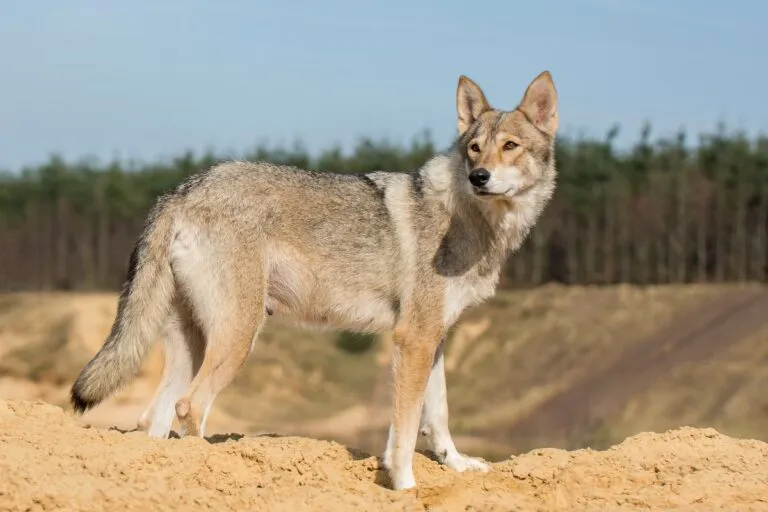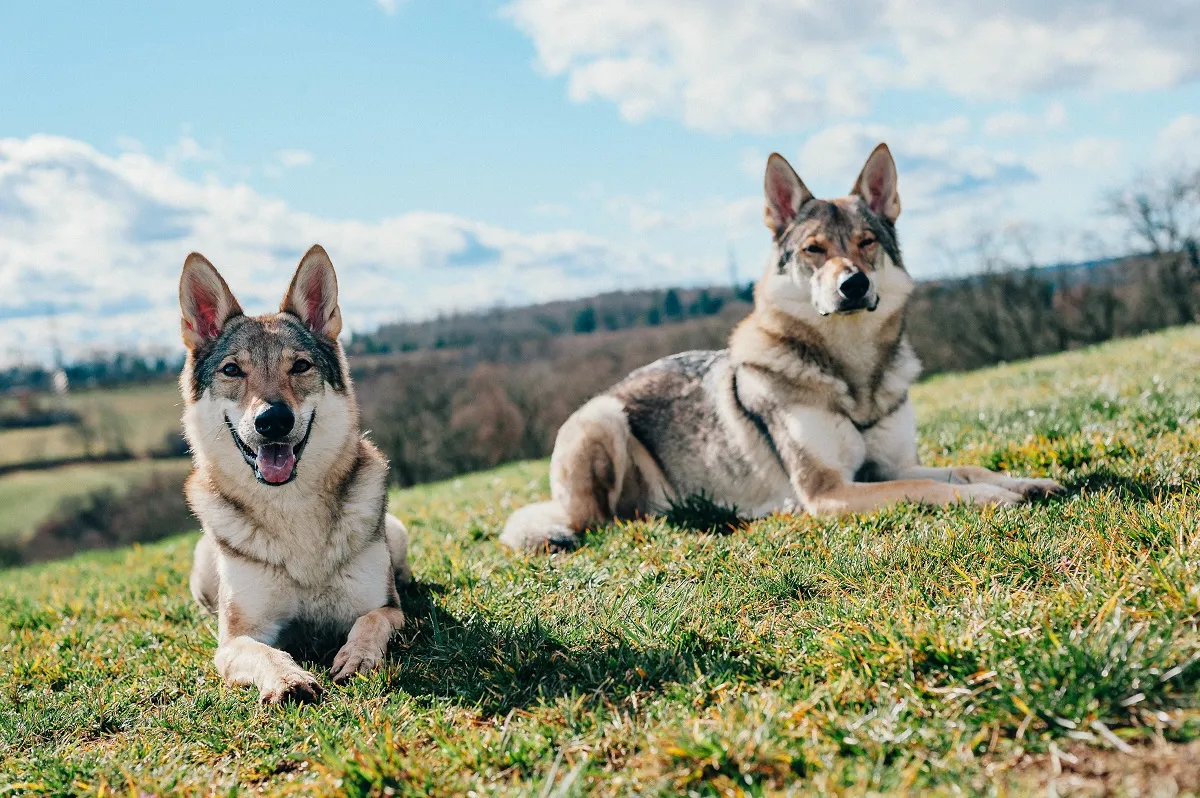Medium Size Poodle
The Tamaskan is what’s known as a replica breed. This refers to a breed that is bred to closely resemble the wild ancestor of our domestic dogs, the wolf. Despite its original appearance, the Finnish Tamaskan is considered a sociable, obedient dog, suitable as both a working and companion animal.

© gebut / stock.adobe.com
The Tamaskan looks like a wolf, but is a loyal family and working dog.
Visually, the Tamaskan is reminiscent of the North American Timberwolf. Males reach a shoulder height of between 65 and 76 centimetres, while females grow to 60 to 70 centimetres. Males weigh between 30 and 50 kilograms, and females between 22 and 40 kilograms.
This means the Finnish breed belongs to the medium to large dog breeds. The body is strong and muscular, with a deep chest and a straight back. The build is similar to that of the German Shepherd.
The Tamaskan’s coat contributes to its resemblance to the wolf. The weather-resistant fur is short, straight, and coarse. Depending on the season, it has a more or less dense, soft undercoat.
The coat colour ranges from black-grey, wolf-grey, red-grey to silver-grey. A distinctive feature is the wolf mask that adorns the animal’s face. Solid-coloured and white examples do exist, but they do not meet the breeding standard.
Especially males can have a striking ruff around the neck.
The almond-shaped eyes are yellowish, amber, or brown. The medium-sized, triangular ears stand upright and are well-furred. Its nose is black and may show lighter patches in winter, known as a snow nose.
The Tamaskan’s long, bushy tail should ideally reach down to the dog’s hock. The breeding standard also includes a complete scissor bite with 42 teeth and narrow, close-fitting lips.
Its wild appearance gives the Tamaskan strength, pride, and dignity. Nevertheless, according to the standard, it should also have the positive traits of an affectionate, loyal family dog. As such, the Finnish breed is considered friendly, intelligent, and tolerant.
The Tamaskan is very much a pack animal and should ideally be allowed to live with other dogs. It usually also gets along well with cats and other pets, provided it has been properly socialised.
Its hunting instinct is generally quite low and can be well managed with gentle training methods.
This lovable, well-balanced dog usually gets on well with children too. As a family dog, however, the hard-working Tamaskan will only thrive if it is kept physically and mentally stimulated.
He does not like to be left home alone for long periods.
If this energetic dog gets bored, it may develop unwanted behaviours, such as running away or destroying furniture. Like most Nordic breeds, the Tamaskan has a certain stubbornness.
It tends to question its owner’s commands and instructions, which is why it’s not necessarily recommended for first-time dog owners.
The Tamaskan is a sporty, active dog that needs plenty of exercise – at least two hours a day is a must. In addition to daily walks, it should have access to a garden where it can let off steam.
The agile Finn is also well-suited to various dog sports, including agility and canicross.
As there are various sled dog breeds among its ancestors, the Tamaskan can also be used for dog pulling sports such as bikejöring. It also excels as a tireless pack dog and in tracking work.
Thanks to its friendly, gentle nature, it could also be trained as a therapy dog. However, as a guard dog, the Tamaskan is not suitable, as it is open or at least reserved towards strangers.
Like many other Nordic breeds, this wolf-like dog also tends to bark and howl more than average. A rural setting, ideally without close neighbours, is therefore best for it.
Keeping a Tamaskan solely indoors is not recommended.
The Tamaskan’s double, short coat does not require much grooming. Usually, brushing the coat once a week is sufficient. Only during moulting should you brush more often to remove loose hair and dirt.
During this time, you can also check the skin for injuries, eczema and parasites.
The dog’s eyes should be checked regularly for redness, inflammation and excessive tearing. The ears should also be checked from time to time to detect any ear infections early.
If the strong, fast-growing claws do not wear down naturally, they need to be trimmed.
Giving chew treats and toys helps prevent dental problems such as tartar. It’s also a good idea to get your dog used to tooth brushing from an early age.
A large, active dog like the Tamaskan needs high-quality food with a balanced nutrient content. Protein-rich dry or wet food without added sugar, grains, flavourings, colourings, or preservatives is recommended. It is also possible to feed raw (BARF).
In general, the Tamaskan is considered a robust dog. However, as the breed is still young and has a small gene pool, certain hereditary diseases do occur repeatedly.
Reputable breeders therefore test their animals for elbow and hip dysplasia, dwarfism, progressive retinal atrophy, and degenerative myelopathy.
In the breed’s history, inbreeding has occurred, which means this breed has a genetic predisposition to cryptorchidism. This health issue is also known as undescended testicle: one testicle does not descend into the scrotum but remains in the abdominal cavity.
This increases the risk of developing a tumour.
Other diseases that are more frequently observed in this breed include Addison’s disease and epilepsy.
For a large dog, the Tamaskan has a comparatively high life expectancy. Dogs of this breed can live up to 14 or 15 years.
In the 1980s, Welsh breeder Edwina Harrison began breeding dogs that looked as wolf-like as possible but had family-friendly traits. She used imported sled dogs and sled dog mixes for this purpose.
She crossed these with Siberian Huskies, Alaskan Malamutes, Samoyeds, Canadian Eskimo Dogs, and German Shepherds.
Their offspring were exported to Finland and further crossed with original-looking sled dogs. Initially, the new breed was called “Wolf-Dog”, later renamed “Northern Inuit”. Whether the Northern Inuit and the Tamaskan are actually the same breed or simply share the same origin is still debated today.
To combat the health problems caused by inbreeding and to give the new breed further positive traits, other breeds such as the Saarloos Wolfdog and the Czechoslovakian Wolfdog were introduced. Selected crossbreeds that resemble the Tamaskan are also used in breeding.
The Tamaskan has not yet been officially recognised as a separate breed by the FCI, the international canine organisation.
Fans of TV series will know the Finnish breed from the first season of the fantasy series “Game of Thrones”, where these dogs played the role of the direwolves. Incidentally, the name “Tamaskan” translates as “strong wolf”.
 © Jakub Vít/Wirestock / stock.adobe.com
© Jakub Vít/Wirestock / stock.adobe.com
The Tamaskan is a very rare breed. Finding a reputable breeder can therefore be difficult. If you are looking for a puppy, you should contact the Tamaskan Society, which is represented in various European countries.
Due to the small number of litters, the waiting time for a puppy can be two to three years.
In an animal shelter, the Tamaskan is rarely found due to its low numbers. Nevertheless, it’s worth visiting local animal welfare organisations.
Many animal shelters have various Nordic breeds and sled dog mixes waiting for a new home. Often, these hard-working dogs were acquired without enough thought and later given up due to being too much to handle.
The Tamaskan delights dog lovers with its wild, wolf-like appearance and friendly nature. It needs experienced owners who can handle its need for exercise and its slight stubbornness. If you train your Tamaskan consistently and keep it busy in a way that suits the breed, you’ll have a friend for life by your side.
| Special features: | The Tamaskan combines a wild, wolf-like appearance with the positive traits of a family dog. |
| Character: | balanced, intelligent, loyal, independent |
| Shoulder height: | 65-76 cm (males) 60-70 cm (females) |
| Weight: | 30-50 kg (males) 22-40 kg (females) |
| Coat: | short, straight, coarse, with undercoat Black-grey, wolf-grey, red-grey or silver-grey, with characteristic mask |
| Coat care: | low maintenance |
| Exercise: | needs plenty of activity and movement |
| Suitable for beginners: | no |
| Barking: | barks a lot |
| Life expectancy: | up to 15 years |
| Typical diseases: | cryptorchidism, progressive retinal atrophy, Addison’s disease, epilepsy, hip dysplasia. |
| FCI group: | not recognised |
| Activity level: | high |
| Origin: | Finland |
Fans of the Bearded Collie agree that those who aren't familiar with this dog breed simply have to get acquainted with it. And those who have experienced how a Bearded Collie bolts across meadows with its flowing fur, how it rolls around full of energy and joy and how it attentively and observantly takes into account its owners wishes become simply addicted to this original dog breed and its unique charm.
The Goldendoodle isn't a breed, but a pairing between Golden Retrievers and Medium or Standard Poodles. Marketed as a low-maintenance dog for allergy sufferers, this hybrid is enjoying increasing popularity amongst dog lovers, similar to the Labradoodle.